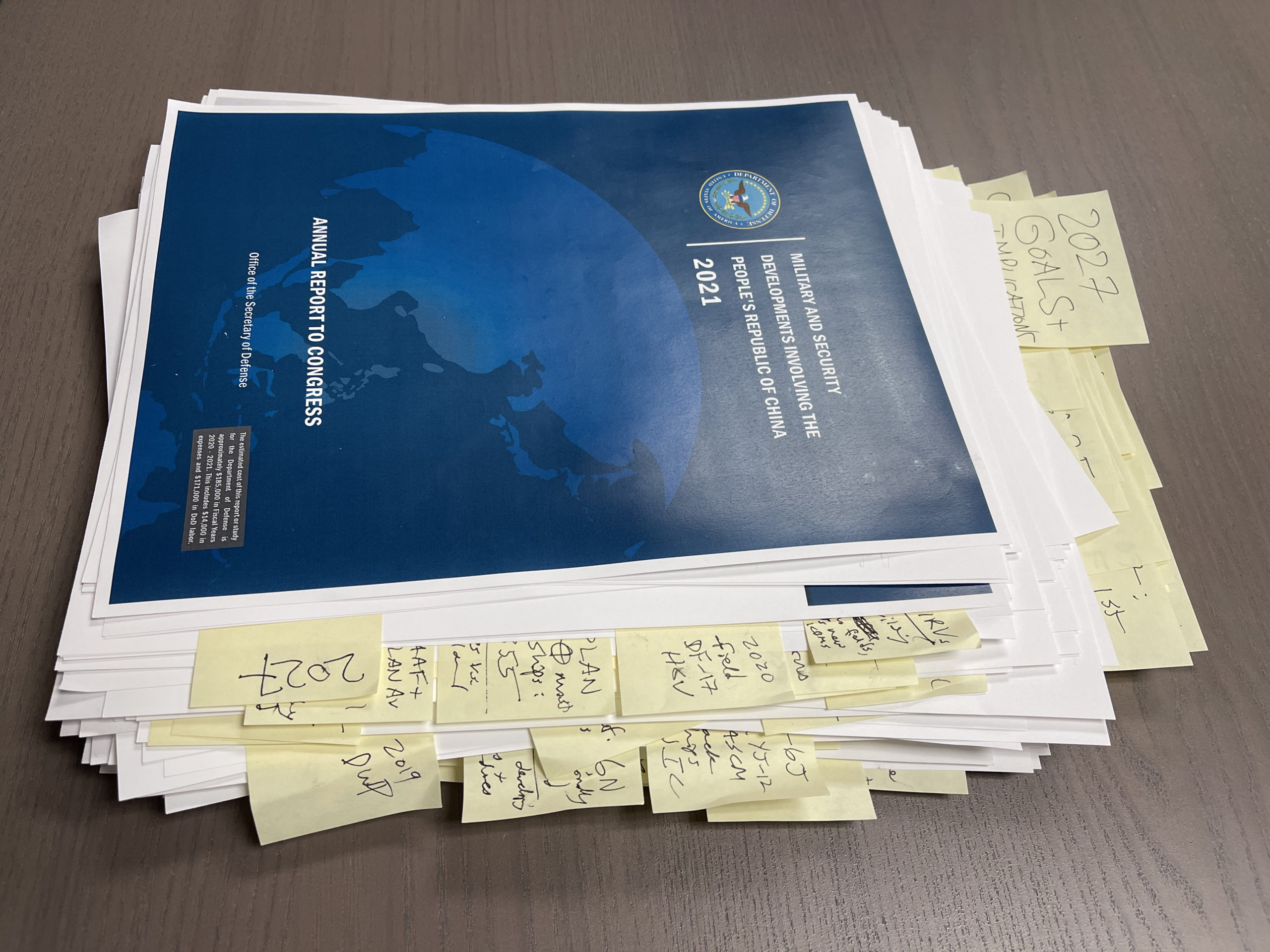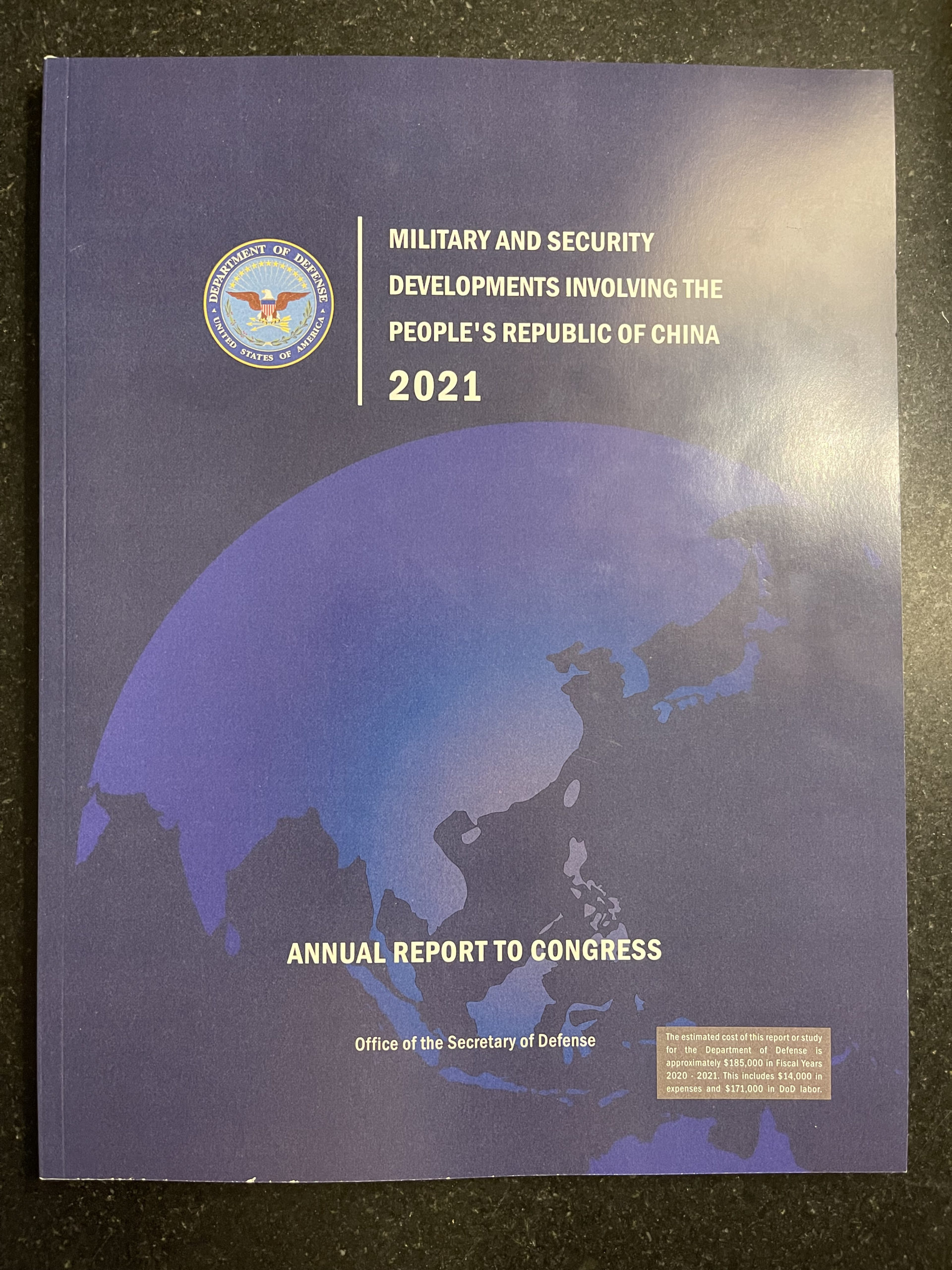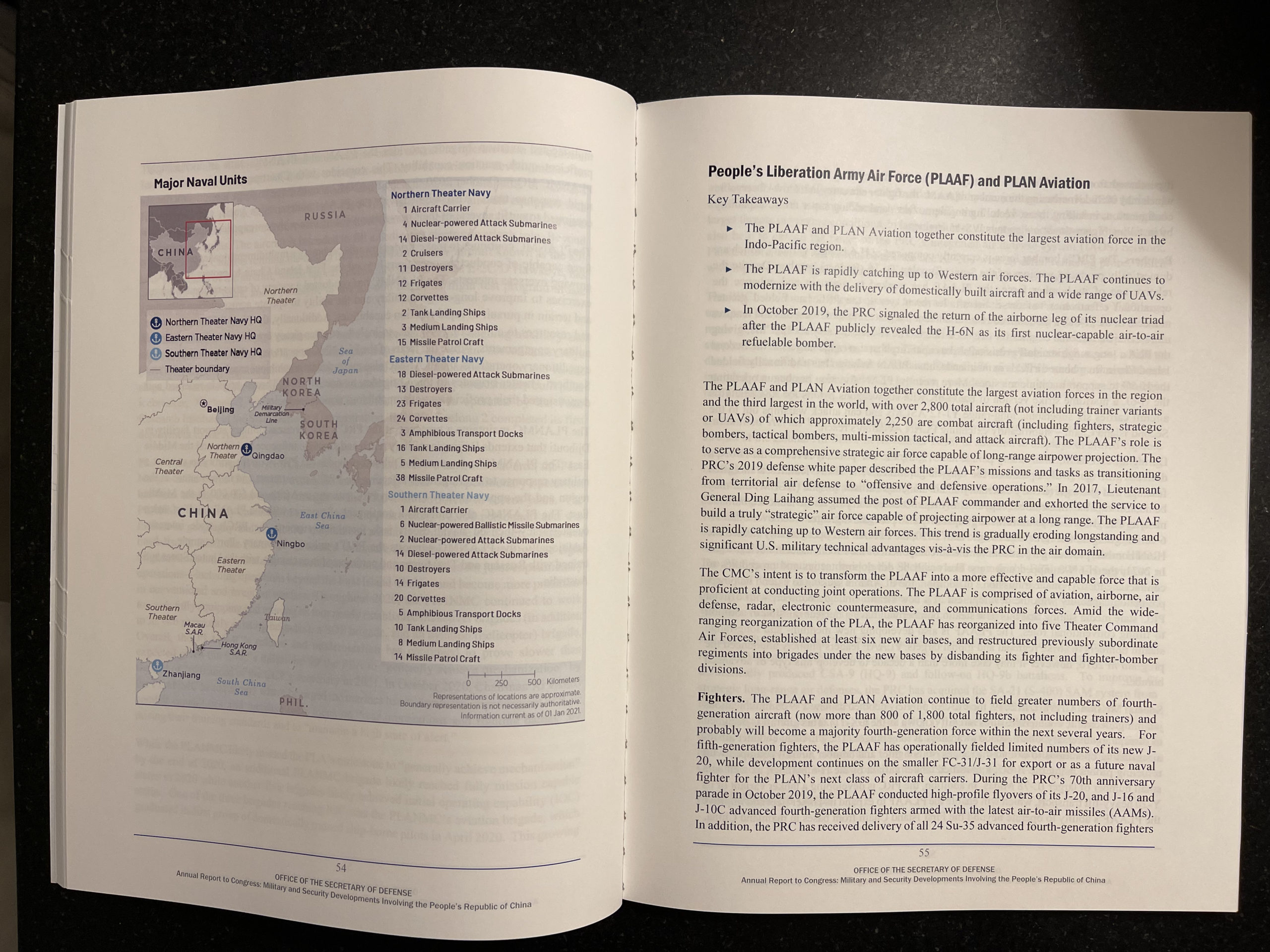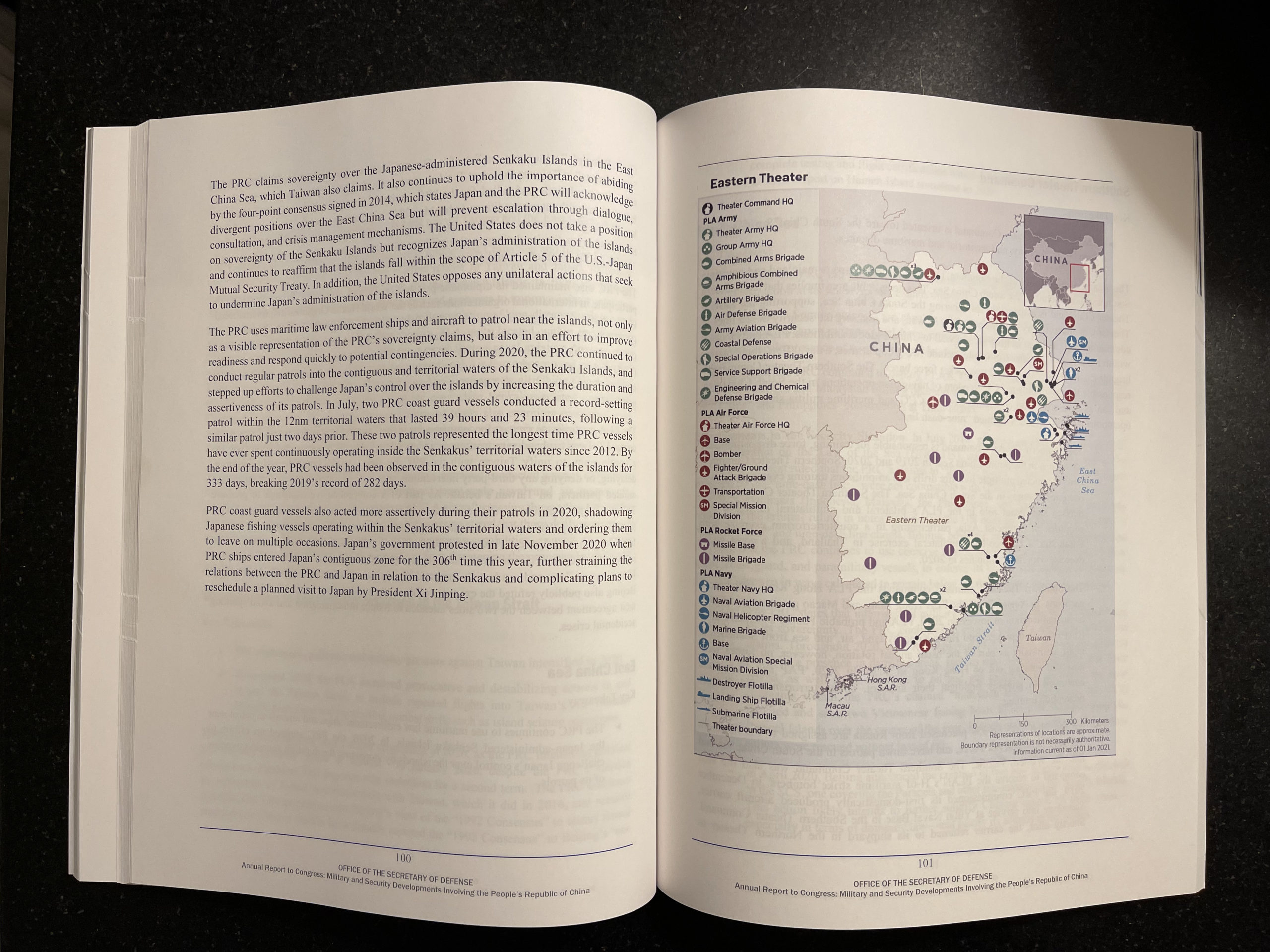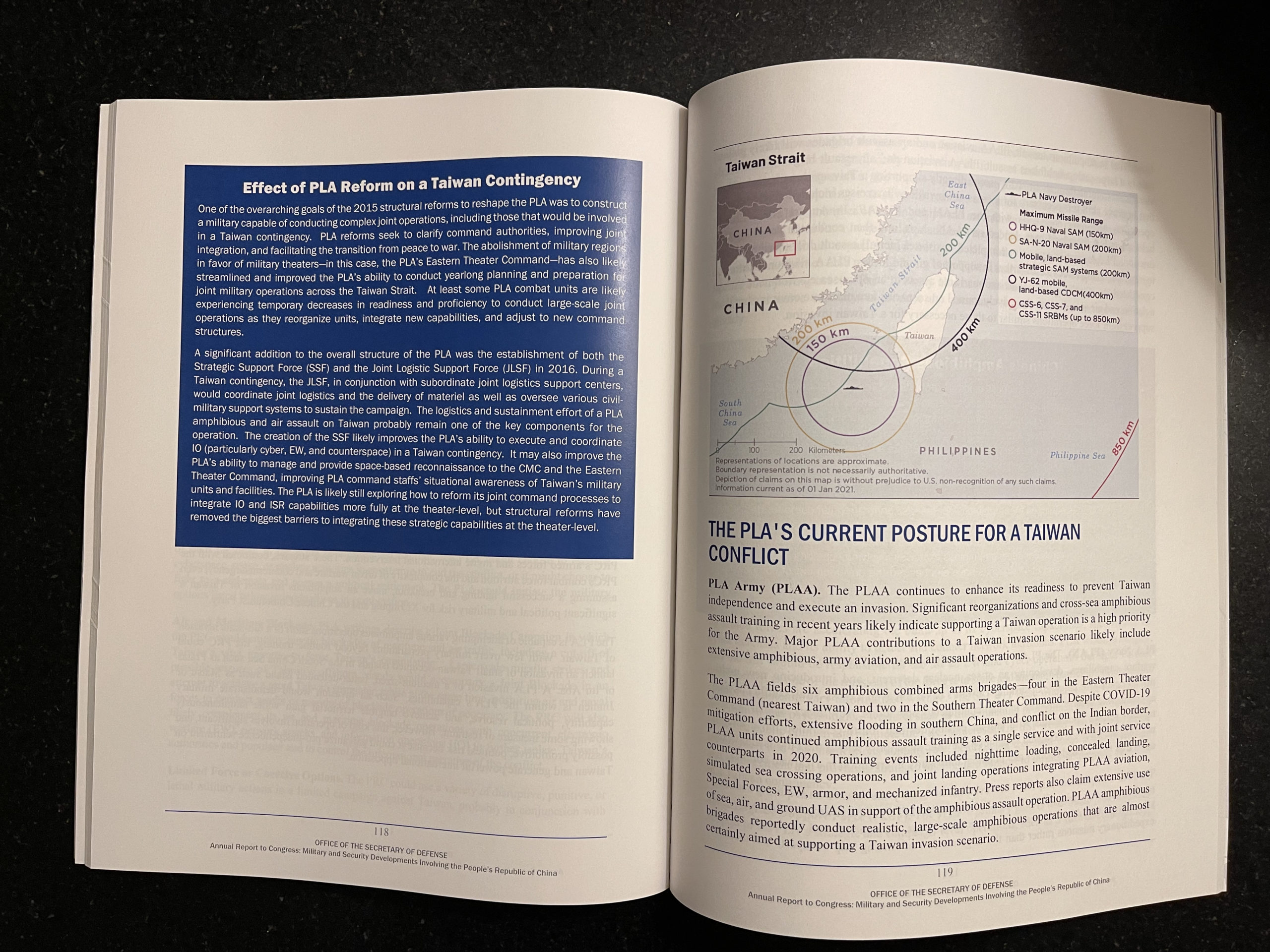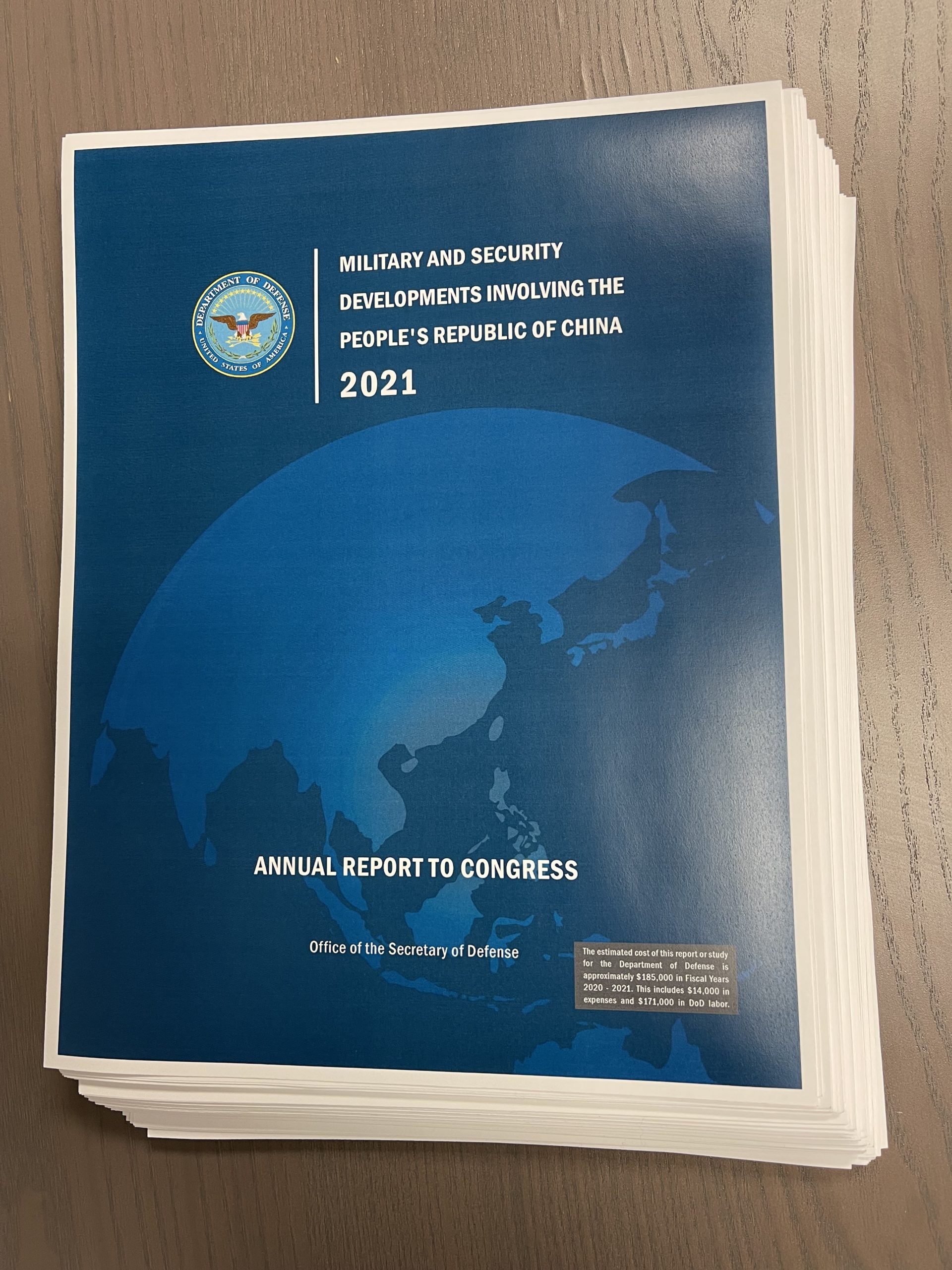The Pentagon’s 2021 China Military Power Report: My Summary
Updated 7 November 2021
The Pentagon’s 2021 China Military Power Report: My Summary
Worth Waiting For—Now No Time to Waste!
Andrew S. Erickson
Despite coming out late in the year, the Pentagon’s 2021 China Military Power Report (CMPR) was worth the wait. Policy-makers, planners, and concerned members of the public should absorb its concerning insights without delay. Demetri Sevastopulo, the Financial Times’s U.S.-China correspondent, was the first out of the gate with one of the very best media writeups. Thomas Shugart, Adjunct Senior Fellow at the Center for a New American Security (CNAS), belted out an incisive play-by-play on Twitter. Here, I offer a comprehensive distillation—I stayed up all night reading and weighing every word so that you don’t have to!
Since the first edition in 2000, the annual CMPR issued by the Department of Defense (DoD) has offered government-verified data on China’s meteoric military rise simply unfindable or unconfirmable anywhere else. While the 2020 edition was particularly impressive, the new report has a claim to being the best one yet. Today’s top takeaways arguably fall into the categories of triad, timing, and trends.
Triad
The 2021 CMPR’s most explosive revelations are clearly in the nuclear realm, where China has finally established a triad and is rapidly expanding its land-based nuclear missile force. In a shocking increase from its own 2020 estimates, DoD forecasts that China may have up to 700 deliverable nuclear warheads by 2027, and at least 1,000 warheads by 2030. As part of this buildup, by around 2027, “the number of warheads on the PRC’s [People’s Republic of China’s] land-based ICBMs capable of threatening the United States is expected to grow to roughly 200….”
The CMPR cites the State Department’s April 2020 Executive Summary of Findings on Adherence to and Compliance with Arms Control, Nonproliferation, and Disarmament Agreements and Commitments to spotlight potential PRC nuclear weapons-related activity amid opacity, underscoring concern across time and presidential administration: “China’s possible preparation to operate its Lop Nur test site year-round, its use of explosive containment chambers, extensive excavation activities at Lop Nur, and lack of transparency on its nuclear testing activities – which has included frequently blocking the flow of data from its International Monitoring System (IMS) stations to the International Data Center operated by the Preparatory Commission for the Comprehensive Nuclear Test-Ban Treaty Organization – raise concerns regarding its adherence to the ‘zero yield’ standard adhered to by the United States, United Kingdom, and France in their respective nuclear weapons testing moratoria.”
On a potentially-related note, the CMPR states: “PRC strategists have highlighted the need for lower-yield nuclear weapons in order to increase the deterrence value of the PRC’s nuclear force…. A 2017 defense industry publication indicated a lower-yield weapon had been developed for use against campaign and tactical targets that would reduce collateral damage. … The DF-26 is the PRC’s first nuclear-capable missile system that can conduct precision strikes, and therefore, is the most likely weapon system to field a lower-yield warhead in the near-term.”
Finally, the CMPR explains that PRC is pursuing a launch-on warning posture—mulled previously in the 1970s and 1980s when necessary early warning systems proved unreliable; while increasing plutonium production and separation capacity through such infrastructure as fast breeder reactors and reprocessing facilities.
After years of ambiguous wording as to whether China’s nuclear-powered, ballistic missile-carrying submarines (SSBNs) were finally operational, and what that actually meant in practice, the 2021 CMPR is the first edition to confirm that China’s nuclear triad now has a “viable sea-based nuclear deterrent.” This full-fledged sea leg consists of six operational Jin-class Type 094 SSBNs—with two entering service despite the Coronavirus pandemic, amid an overall record of steady People’s Liberation Army Navy (PLAN) outfitting during COVID. Each SSBN carries up to 12 operational CSS-N-14 (JL-2) SLBMs. With a range of 7,200 km, these JL-2s’s performance parameters would require the SSBNs carrying them to “operate in areas north and east of Hawaii if the PRC seeks to target the east coast of the United States,” but a JL-3 follow-on may well allow coverage of the entire continental United States from protected bastions in the Bo Hai or South China Sea. China has prioritized ballistic missile development since the 1950s, and now produces world-class missiles according to the CMPR—so I would bet on particularly rapid PRC progress in this area.
Finally, its 70th anniversary parade in October 2019, the PRC “signaled the return of the airborne leg of its nuclear triad after the PLAAF [PLA Air Force] publicly revealed the H-6N as its first nuclear-capable air-to-air refuelable bomber.” This year, the report projects, “the H-6N-equipped unit very likely will be developing tactics and procedures to conduct the PLAAF nuclear mission.”
In sum, China has clearly arrived as a top-tier nuclear weapons state across the board. Its deterrence relations with the United States will reach new levels of difficulty and complexity in coming years.
Timing
The CMPR showcases a concerning convergence of PRC capabilities, particularly around the key milestone goal year of 2027, the 100th anniversary of the PLA’s founding. Outgoing U.S. Indo-Pacific Commander Admiral Phil Davidson warned cogently in March that PLA capabilities and likely intentions to threaten Taiwan are surging towards an unprecedented, dangerous level by around 2027. Testimony from his successor, Admiral Aquilino; as well as Chairman of the Joint Chiefs of Staff, Mark Milley, suggest a similar timescale of converging cross-Strait threats.
Now DoD’s 2021 report contextualizes and reinforces these assertions powerfully, including with the aforementioned projection that China may have up to 700 deliverable nuclear warheads just six years hence. The CMPR offers a bottom line up front: “In 2020, the Chinese Communist Party (CCP) announced a new milestone for PLA modernization in 2027 broadly understood as the modernization of the PLA’s capabilities to be networked into a system of systems for ‘intelligentized’ warfare. If realized, the PLA’s 2027 modernization goals could provide Beijing with more credible military options in a Taiwan contingency.”
Citing the 2019 defense white paper, and updated 2020 communiqué following the 5th Plenum of the 19th Central Committee in October 2020, the CMPR states that by 2027 China’s People’s Liberation Army (PLA) aims to: “Accelerate the integrated development of mechanization, informatization, and intelligentization, while boosting the speed of modernization in military theories, organizations, personnel and weapons and equipment.” The 2020 communiqué “added a new milestone for PLA modernization in 2027.
While the new 2027 goals did not clearly shift forward any of the PLA’s declared modernization for 2035 and 2049 objectives, it did likely shift the PLA’s development of certain capabilities within the categories of the integrated development of mechanization, informatization, and intelligentization.” The CMPR explains: “PLA spokespeople have stressed that the 2027 goal means that the Chinese military should “comprehensively push forward the modernization of military theories, military organizational form, military personnel, and weapons and equipment.” It elaborates: “PRC media, citing a military source, connected the PLA’s 2027 goals to developing the capabilities to counter the U.S. military in the Indo-Pacific region, and compel Taiwan’s leadership to the negotiation table on Beijing’s terms.”
Clearly, the recent focus by Admiral Davidson and other U.S. officials on relentlessly-mounting PLA threats to Taiwan potentially peaking by 2027 is not based solely on close-hold information—although that undoubtedly factors in. As the CMPR underscores, reviewing the PRC’s own public documents reveals a similar timeline. To that, I would add, the unexpectedly-rapid buildup of nuclear and conventional weapons systems the report documents further underscores this timing of threat. As usual, Beijing is often transparent about its broad intentions, and is typically more transparent in Chinese.
Trends
This is the first CMPR to state explicitly that China’s Navy and Coast Guard each have the world’s largest number of ships. Moreover, this year’s report traces a naval buildup that is truly staggering its top-line numbers. The PLAN ship numbers cited appear significantly higher than even those large figures that the U.S. Navy has previously projected in the past, as disclosed to veteran Congressional Research Service analyst Ronald O’Rourke.
The CMPR reports a tidal wave of seapower. China’s navy has “a battle force of approximately 355 platforms, including major surface combatants, submarines, aircraft carriers, ocean-going amphibious ships, mine warfare ships, and fleet auxiliaries. This figure does not include 85 patrol combatants and craft that carry anti-ship cruise missiles (ASCMs). The PLAN’s overall battle force is expected to grow to 420 ships by 2025 and 460 ships by 2030. Much of this growth will be in major surface combatants.” This significantly exceeds the most recent public U.S. Navy projection—estimates of 400 by 2025 and 425 by 2030, as provided to O’Rourke and republished by him as recently as 7 October 2021 (in Table 2, p. 10, for those following closely). A PLAN ship estimate increase of 20 by 2025 and 25 by 2030 calls for explanation and elaboration by relevant U.S. officials. For reference, the U.S. Navy currently has approximately 300 battle force ships.
Regarding amphibious vessels, the CMPR mirrors the China Maritime Studies Institute 2021 conference’s conclusion that China is currently building landing platform docks (LPDs) and landing helicopter assault (LHA) ships suited for expeditionary operations rather than the landing ship, tanks (LSTs) and landing ship, mediums (LSMs) optimized for beach assault. But, as the CMPR points out, “The PLA may also have confidence in the PRC’s shipbuilding industry’s massive capacity to produce the necessary ship-to-shore connectors relatively quickly.”
For its part, the PLAAF is “rapidly catching up to Western air forces” and “gradually eroding longstanding and significant U.S. military technical advantages….” Shugart summarizes the CMPR’s findings in this area incisively, in comparison to the 2020 edition: “the PLAAF & PLANAF [PLAN Aviation] now have 2,800 total aircraft (+300) of which 2,250 (+250) are combat aircraft. Based on totals elsewhere, this looks to be mostly an increase in the number of fighters (+300) but not in 4th-gen ones (constant at 800).” As I observed in person at four of the last five Zhuhai Airshows, China is also developing and deploying a panoply of UAVs, and is now the world’s second-largest exporter.
China continues a similarly significant buildup and testing of its long-running standby: ballistic and cruise missiles. In Shugart’s words, “there are some pretty eye-watering updates to the PLA Rocket Force. Where last year’s report had a huge increase to ‘200’ IRBM [intermediate-range ballistic missile] launchers and ‘200+’ missiles, this year’s pegs the IRBM missile total at 300.” Shugart continues: “But the really eye-popping jump in this year’s report is the number of MRBMs [medium-range ballistic missiles], from last year’s 150 launchers to 250, and from ‘150+’ missiles to 600! Given that the report earlier classed the DF-17 as an MRBM HGV [hypersonic glide vehicle], I’d guess that might be much of this increase. Not good…” Shugart adds: “Another new nugget in the ICBM section is a statement that the PRC ‘already appears to be doubling the numbers of launchers in some ICBM units.’ It’s unclear if this is referring to silos, or a doubling of mobile launchers in ICBM units.”
Ballistic missiles include the nuclear/conventional/anti-ship ballistic missile (ASBM) DF-26; the initial DF-21D ASBM, which “is reportedly capable of rapidly reloading in the field”; and the DF-17 (which may have a nuclear warhead option), China’s first operational hypersonic weapons system, which it began deploying in 2020. Intriguingly, the CMPR also references an obscure, virtually un-Googleable “DF-27,” which “could be a new IRBM or ICBM” depending on its actual range.
As for maximizing capabilities to operate such weapons effectively, in 2020, the PLA Rocket Force [PLARF] “launched more than 250 ballistic missiles for testing and training… more than the rest of the world combined.” And the previous two years have witnessed significant ASBM tests: “On August 26 [2020], the PLARF test-fired four medium-range ballistic missiles into the South China Sea, marking the second consecutive year that the PLA has conducted such a test. In July 2019, the PLARF conducted its first-ever confirmed live-fire launch into the South China Sea, firing six DF-21D anti-ship ballistic missiles into the waters north of the Spratly Islands.”
PLA missiles and other “counterintervention” weapons are part of a comprehensive pattern: we can see Beijing preparing to attempt to deter or defeat American defense of Taiwan in coming years by claiming a potent weapons-based capability for every possible scenario contingency and escalation.
Other Revelations
Dedicated CMPR sections illuminate authoritatively two new and important forces: the PLA Strategic Support Force (SSF) and Joint Logistic Support Force’s (JLSF). Periodic updates include the latest People’s Armed Forces Maritime Militia (PAFMM) patrols; operations in Natuna Sea waters claimed by Indonesia—a concrete confirmation of Ryan Martinson’s pioneering research concerning PAFMM units from Beihai City, Guangxi; and PAFMM harassment of South China Sea neighbors’ oil and gas exploration.
Research, development, and acquisition of weapons systems remains one of the PRC’s greatest strengths. The PLA is a constant beneficiary. China accesses, develops, and applies technology by all means possible on military-industrial scale—domestic, foreign, and everything in between. To do so, it leverages the world’s largest human and organizational infrastructure technology acquisition and application infrastructure. This, of course, includes all manner of espionage, cyber, and illicit technology transfer efforts. Here the CMPR documents some particularly noteworthy examples of PRC efforts; and underscores the extraordinary defensive efforts underway across the United States. With the FBI as the lead agency to stem the tide, the report offers several staggering statistics:
“In 2020, the FBI opened a new PRC-related counterintelligence case about every 10 hours. FBI Director Christopher Wray also stated that ‘of the nearly 5,000 active FBI counterintelligence cases currently underway [in 2020], almost half are related to the PRC.’ In addition, the FBI has seen economic espionage cases with a link to the PRC increase by approximately 1,300% over the past decade.”
For all its documentation of PRC strengths—particularly in hardware, the CMPR also takes pains to address the important intangibles of what might be termed ‘software’—weapons targeting capability, training sophistication, and readiness; and generally finds concerted PLA focus and progress across the board. Any initial setbacks and restrictions from the Coronavirus pandemic are already well into the rearview mirror.
With respect to targeting, the 2021 CMPR credits China with “more than 200” reconnaissance and remote sensing satellites, and increase of 80 from last year’s estimate. This year’s report elaborates, “the PLA owns and operates approximately half of these systems, most of which could support situational awareness of regional rivals and potential flashpoints, while monitoring, tracking, and targeting an adversary’s forces.”
A continually world-leading launch rate is helping to rapidly increase both PRC space and counterspace capabilities. As the CMPR explains, the latter include direct ascent, co-orbital, electronic warfare, and directed energy capabilities; specifically, “kinetic-kill missiles, ground-based lasers, and orbiting space robots, as well as expanding space surveillance capabilities, which can monitor objects in space within their field of view and enable counterspace actions.”
As China increasingly seeks to project power to safeguard its growing overseas interests, it prioritizes locations that can help it secure sea lanes to and from the Strait of Hormuz, Africa, and the Pacific Islands. Regarding the PLA’s first overseas facility in Djibouti, the CMPR documents clearly and disturbingly: “PLA personnel at the facility have interfered with U.S. flights by lasing pilots and flying drones, and the PRC has sought to restrict Djiboutian sovereign airspace over the base.”
Additionally, the CMPR states that Beijing “has likely considered” the following candidate countries to host (1) PLA bases with stationed forces, or (2) exclusive PLA logistics facilities with prepositioned supplies (as opposed to the more prevalent access to commercial infrastructure abroad): Cambodia, Myanmar, Thailand, Singapore, Indonesia, Pakistan, Sri Lanka, United Arab Emirates, Kenya, Seychelles, Tanzania, Angola, and Tajikistan. Additionally, the report states, “The PRC has probably already made overtures to Namibia.” Together with Pakistan and Argentina—as the CMPR relates—Namibia is one of only three countries from which China operates tracking, telemetry, and command stations. Strategically situated along South Atlantic sea lanes, the sparsely populated but resource-rich sub-Saharan nation will be interesting to watch indeed.
What the report lacks space to explore is that Namibia is the world’s fourth-largest producer of uranium oxide. In one of China’s single largest investments in Africa, a subsidiary of China General Nuclear Power Company owns the Husab open-pit uranium mine, the world’s third-largest uranium mine (6% of global production). The Rossing Uranium mine, majority owned by China National Uranium, boasts the world’s largest igneous-rock-associated uranium deposit, is the world’s fifth-largest uranium oxide supplier, producing 4% of uranium worldwide in 2019.
Meanwhile, as part of its border standoff with India, “Sometime in 2020, the PRC built a large 100-home civilian village inside disputed territory between the PRC’s Tibet Autonomous Region and India’s Arunachal Pradesh state in the eastern sector of the LAC [Line of Actual Control].” This is a typical PRC technique, recently documented in detail regarding Bhutanese borderland areas by Robert Barnett and colleagues in a pathbreaking Foreign Policy series.
Additionally, the CMPR raises some worrisome questions, even as it does not offer full answers. Citing the offensive biological weapons program that the U.S. government assesses China to have had from the 1950s to the late 1980s at least, the CMPR alleges both continued opacity and “biological activities with potential dual-use applications, which raise concerns regarding [China’s] compliance with the Biological and Toxins Weapons Convention (BWC) and the Chemical Weapons Convention (CWC).” Specifically, the CMPR cites “Studies conducted at PRC military medical institutions discussed identifying, testing, and characterizing diverse families of potent toxins with dual-use applications.” The CMPR’s extensive wording and citation of State Department documents concerning dual use toxin testing suggests that there may be more to this story beyond the public eye—apparently among the inherent limitations of an unclassified report. Reporters around the world should be on the case.
Takeaways
Particularly well-written, this year’s CMPR prose is fresh, sharp, and avoids the just-slightly-updated feel of some early editions. While the CMPR’s greatest value has always been the specific and technical information it uniquely provides, this one offers a tremendous amount of useful background and context regarding more abstract history, strategy, and policy issues. Such information may be found elsewhere piecemeal, but here it is conveniently integrated in one document for one-stop reading and keyword searching. Those pressed for time may skip background content (e.g., mind-numbing details of Military-Civil Fusion) in the 173-page tome, but its careful interweaving bespeaks comprehensive, contextualized analysis.
Reactions to the 2021 CMPR will depend in part on what it is and is not, and who understands this. Per Congressional directive through the National Defense Authorization Act (NDAA), its core contents are PLA developments during the 2020 calendar year—a repeated reality that may have thwarted reference to China’s apparent test of a Fractional Orbital Bombardment System in August 2021, even though some other 2021 events have indeed been included. There are always issues that invite nitpicking… including, from me, on a small but critical issue: the CMPR’s unfortunate reference in one instance to “China’s ‘Near Seas’”—in fact, the Yellow, East, and South China Sea do not belong to Beijing, which is precisely the point!
Moreover, informing the public about PRC military developments should not ride exclusively on the CMPR. Instead, other key stakeholder agencies should continue to complement and supplement the CMPR by releasing their own reports on a timely basis. For example, the Office of Naval Intelligence (ONI) published an excellent report on the PLAN, together with accompanying multimedia, in 2015—but it is crying for an update, particularly with the stunning growth of China’s sea forces over the last six years. Time for Suitland to contribute its latest insights to the public discussion!
In the final analysis, how should we read this latest CMPR? Most fundamentally: as a clarion call to meet China’s challenge before regional security, U.S. alliances, and the rules-based international order suffer grave, irreversible damage. As Gabriel Collins and I wrote in our recent Foreign Policy article on the peaking PRC threat to Taiwan, U.S. vital interests, and the rules-based international order: “U.S. military leaders’ assessments are informed by some of the world’s most extensive and sophisticated internal information. But what’s striking is open-source information available to everyone suggests similar things.” I discussed this issue further in a Midrats podcast last Sunday. Now, with its extensive data and analysis free for the world to read, the CMPR brings it all together.
The future is now: the United States and its allies and partners must prepare immediately to Weather the Window of Vulnerability through this Decade of Greatest Danger that we have already clearly entered. Both military and information preparations are needed urgently. As I recently told ANI News: “Only well-prepared and well-explained US government answers will stem a riptide of stunned defeatism and prevent Xi from ‘winning without fighting.’ ‘Holding the line’ is likely to require frequent and sustained proactive enforcement actions to disincentivize full-frontal PRC assaults on the rules-based order in Asia-Pacific. PRC probing behavior and provocations must be met with a range of symmetric and asymmetric responses that impose real costs.”
The Pentagon’s new China report must inform key decision-makers as well as the general public to marshal the necessary efforts to safeguard peace and security amid Beijing’s mounting challenges to both. The bottom line: Washington and its allies and partners must Hold the Line through 2035. Starting now! There is no time left to waste.

